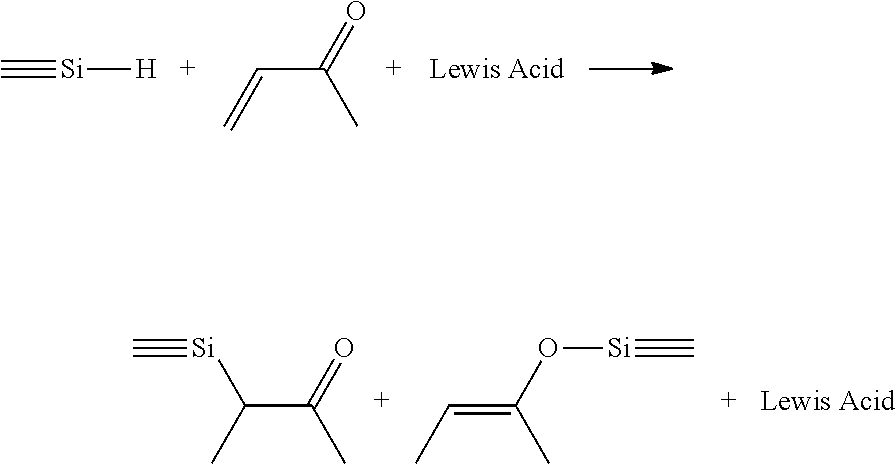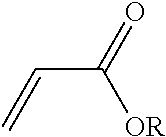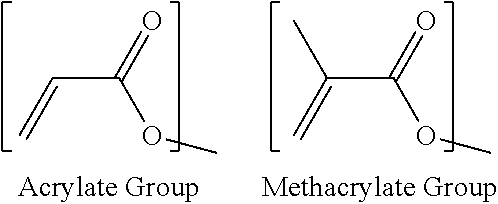BRIDGED FRUSTRATED LEWIS PAIRS AS THERMAL TRIGGER FOR REACTIONS BETWEEN Si-H AND ALPHA-BETA UNSATURATED ESTERS
a technology of frustrated lewis and thermal trigger, applied in the direction of organic compound/hydride/coordination complex catalyst, physical/chemical process catalyst, organic chemistry, etc., can solve the problems of unfavorable recurrence and the tendency of rapid reductive cure reaction
- Summary
- Abstract
- Description
- Claims
- Application Information
AI Technical Summary
Benefits of technology
Problems solved by technology
Method used
Image
Examples
examples
[0061]Materials
[0062]MD50DMA2.6M has the following structure:
(CH3)3SiO1 / 2((CH3)2SiO2 / 2)50((CH3)(CH2CH2CH2OC(O)C(CH2)CH3)SiO2 / 2)2.6O2 / 2Si(CH3)3
[0063]Prepare MD50DMA2.6M in the following manner: Equip a 4-neck one-liter flask with a thermal couple, a mechanical stirrer, a Dean Stark trap adapted water cooled condenser and nitrogen bubbler. Charge to the flask 466.6 g of silanol terminated polydimethylsiloxane (XIAMETER™ PMX-0930 available from The Dow Chemical Company), 75.8 g of 3-methacryloxypropylmethyldimethoxysilane (Gelest), 21.4 g of Dow corning 200 fluid (0.65 cSt), and 124 g of heptane. While vigorously stirring, add 0.40 milliliters (mL) of triflic acid to the flask. Heat to 76° C. Collect water, methanol and heptane in the Dean Stark trap. The refluxing temperature rises to 117° C. after about 4 hours. Remove the heat source and add 15.6 g of calcium carbonate and 32 g of sodium sulfate to the flask at a solution temperature of 101° C. Cool the pot temperature to 23° C. St...
example
(Ex) 1
[0076]Combine 1.68 g of MDH65M and 10 g of MD50DMA2.6M in a dental cup and mix to form a mixture. Add enough B-FLP(1) (dissolved in toluene) to provide 500 weight parts tris-pentafluorophenylborane per one million weight parts mixture to form a reaction composition having a molar ratio of Si—H to alpha-beta unsaturated ester group of 3. The resulting reaction composition cures in more than 5 days at 23° C. and in 20 minutes at 90° C. Ex 1 illustrates that by introducing the Lewis acid as a B-FLP the reaction mixture is shelf stable at 23° C. but still reacts quickly at 90° C.
Ex 2
[0077]Combine 1.68 g of MDH65M and 10 g of MD166DMA14M in a dental cup and mix to form a mixture having a molar ratio of Si—H to alpha-beta unsaturated ester group of 3. Add enough B-FLP(1) (dissolved in toluene) to provide 500 weight parts tris-pentafluorophenylborane per one million weight parts mixture to form a reaction composition. The resulting reaction composition cures in more than 5 days at 23...
PUM
| Property | Measurement | Unit |
|---|---|---|
| temperature | aaaaa | aaaaa |
| temperature | aaaaa | aaaaa |
| temperature | aaaaa | aaaaa |
Abstract
Description
Claims
Application Information
 Login to View More
Login to View More - R&D
- Intellectual Property
- Life Sciences
- Materials
- Tech Scout
- Unparalleled Data Quality
- Higher Quality Content
- 60% Fewer Hallucinations
Browse by: Latest US Patents, China's latest patents, Technical Efficacy Thesaurus, Application Domain, Technology Topic, Popular Technical Reports.
© 2025 PatSnap. All rights reserved.Legal|Privacy policy|Modern Slavery Act Transparency Statement|Sitemap|About US| Contact US: help@patsnap.com



